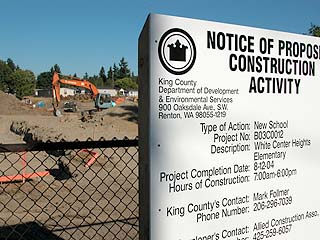|
Subscribe / Renew |
|
|
Contact Us |
|
| ► Subscribe to our Free Weekly Newsletter | |
| home | Welcome, sign in or click here to subscribe. | login |
Construction
| |
 |
August 21, 2003
Insurers slash coverage for contractors
AGC of Washington

Photo by Jon Silver
Toxic mold led to the shutdown of the 55-year-old White Center Heights Elementary building in 1998. The school was subsequently demolished, and now Allied Construction Associates is building an $11.5 million replacement. Insurers have reacted to expensive threats like mold by hiking rates for contractors or excluding coverage altogether.
|
In a 2002 survey, contractors ranked the cost of general liability insurance one of the top five challenges for the next five years.
If anything, the situation has worsened in 2003 with dramatic increases in pricing, slashed coverage, and carriers leaving the construction market altogether. Over 70 percent of the carriers who were writing construction risks in 1996 are no longer doing so.
Along with dramatic price increases, the typical general liability insurance policy — the source of compensation for damages to owners or third parties for injuries or construction defects — doesn’t cover what it did two years ago.
These are the exclusions you can expect to find today in contractor insurance policies:
Mold: A hotbed of litigation, carriers have eliminated coverage under general liability policies. Mold coverage can be purchased under a separate stand-alone policy but the minimum premium is very high.
Recently, a public entity requested alternate pricing for mold coverage on a project in the $300,000 to $500,000 range. One bidder found the cost for the mold coverage would be $80,000.
EIFS (synthetic exterior stucco): Another hotbed of litigation that carriers have eliminated from coverage.
Condominiums: Condo construction is virtually impossible to cover in a traditional way. Well-established construction companies that have done habitational work in the past are being denied coverage altogether, or are finding surplus lines coverage at 300 percent to 800 percent the price they paid last year.
Additional insured status for completed operations: This is typically called for in construction contracts.
Litigation under these provisions has proliferated dramatically, and most carriers are refusing to issue certificates naming general contractors, designers and owners as additional insureds for completed work.
The naming of additional insureds, particularly when combined with a completed operations requirement, is becoming increasingly difficult for many smaller contractors. Specifications recently issued by several Washington school districts require that contractors of every tier maintain the additional insured status for three years following final acceptance of the project.
One specialty contractor was recently quoted a premium of $25,000 to provide this coverage for this year only. The contractor was given no guarantee or indication of availability or price for either the remainder of the period of construction or the three years following final acceptance.
Cost of exclusions
Owners and their representatives need to be aware of these exclusions.
“Unfortunately, these exclusions are more than a temporary ‘blip’ on the radar screen,” says Margo Easton, vice president and general counsel of Ferguson Construction. “We anticipate they will remain once the market returns to ‘normal’ conditions.”
Easton co-chairs AGC of Washington’s general liability insurance task force, which has been studying the insurance market in the state since early 2002.
Easton continues: “As a result of a series of adverse court decisions — as well as the fact that Washington is one of only one of four states that effectively preclude private insurance companies from spreading their liability insurance risk by providing workers compensation coverage — contractors and their clients who want to build in this state will continue to suffer a competitive disadvantage when the market recovers.”
These exclusions will definitely affect the cost of projects.
“It is very difficult for contractors to project the cost of the insurance to meet the contract requirements,” says Pamm Jardine, and insurance broker at Kibble & Prentice. Jardine shares co-chair responsibilities with Easton on AGC’s general liability insurance task force.
For contractors fulfilling contract requirements, Jardine says, “it is not unusual ... to have to include products and completed operations coverage for several years after substantial completion.”
Added risks
Once-standard insurance requirements are reducing the number of companies that can undertake a project. They also introduce the risk that companies who cannot obtain or retain the mandated insurance will not be in compliance with the contract, and that there will not be coverage in the event of a claim down the road.
Ultimately, these insurance exclusions affect the traditional risk allocation model for the commercial construction industry.
In the current market, owners and their representatives need to be alert, aware and upfront about their contractual insurance requirements, and need to carefully examine whether and to what extent they are feasible and affordable.
Ellen S. Alexander is chief operating officer of Associated General Contractors of Washington, and staffs the association’s general liability insurance task force. AGC of Washington is a trade association representing commercial contractors, subcontractors and construction industry suppliers and service providers in Western and Central Washington.
Other Stories:
- America’s ongoing school-building crunch
- Tomorrow’s schools could be neighborhood hubs
- New standards will help schools go green
- Keeping up with the Joneses
- Value engineering pays off for Seattle Schools
- High school embraces small-school format
- Better buildings can boost savings down the road


